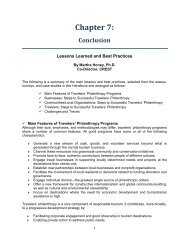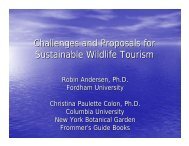Chapter 2: - Center for Responsible Travel
Chapter 2: - Center for Responsible Travel
Chapter 2: - Center for Responsible Travel
You also want an ePaper? Increase the reach of your titles
YUMPU automatically turns print PDFs into web optimized ePapers that Google loves.
By Robert BailesCoordinator, Monteverde <strong>Travel</strong>ers’ Philanthropy InitiativeThis essay is distinct from the other case studies because thisprogram, launched in August 2010 by the Monteverde Instituteand CREST, is still in development. It represents a major newinnovation in the field of travelers‘ philanthropy, one throughwhich tourism businesses within a destination work collectivelyto create a program to provide contributions to a list of projectsthat have been designated as priorities by the community. Theclosest example in this volume is IGTOA, which, as the casestudy explains, brings together key businesses andorganizations operating in the Galapagos Islands, Ecuador.We believe that this destination-level model can be applied inother locations that, like Monteverde, have a strong cohesivecommunity and a recognizable tourism brand. CREST isplanning to launch, together with its local partner FundacionCorcovado, a similar program <strong>for</strong> the Osa Peninsula, CostaRica. We believe that the carefully planned approach beingEnvironmental per<strong>for</strong>mance,Monteverde. Credit: Justin Welshused in Monteverde will help to provide a road map <strong>for</strong> others seeking to launch a destinationwidetravelers‘ philanthropy fund.Why a Destination-Wide Fund?A need to channel the economic wealth of tourism <strong>for</strong> the benefit of the community. Likemany international tourism destinations,Monteverde‘s tourism sector has developedrapidly in a relatively short time period.Monteverde has a local population of only6,000 individuals, yet it receives 240,000visitors a year, drawn by its world renownedcloud <strong>for</strong>est reserve, a growing array of othernature-based attractions, and its dozens ofmainly small-scale, locally-owned eco-lodges.Beginning in the mid-1990s, tourismsurpassed dairy farming as Monteverde‘smost important economic activity. While manytourism businesses espouse strong social andenvironmental principles and most are ownedOn the way to Monteverde, Costa Rica. Credit: tripadvisorby Costa Rican or long time <strong>for</strong>eign residents,only 7 have been certified under Costa Rica‘sCST program and few have organized travelers‘ philanthropy programs.Tourism has brought some benefits to the community, but it has not necessarily delivered anequitable <strong>for</strong>m of development, nor has it effectively channelled the economic wealth of tourisminto local community development. A number of causal factors go toward explaining this failure,71















